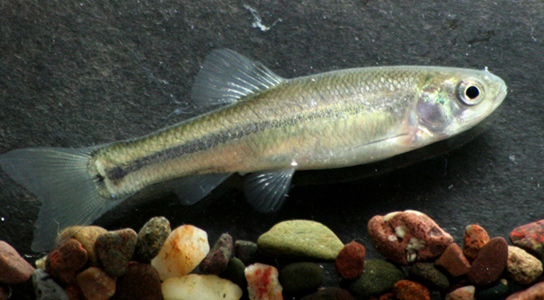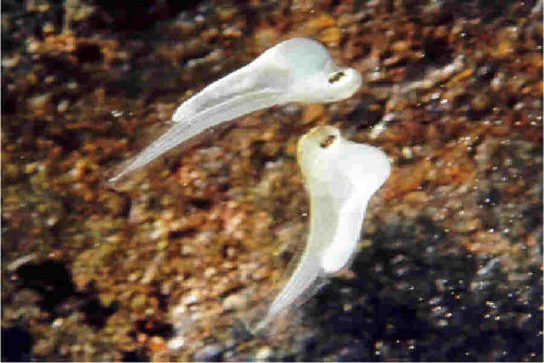Human Contraceptives & Antidepressants Reduce Fish Reaction Times
November 19, 2012

Fathead minnow (Pimephales promelas)
Human medications are ending up in waterways and affecting fish and other aquatic organisms. However, researchers are only beginning to compile the effects that those drugs have on the ecosystem.
Rebecca Klaper, an ecologist at the University of Wisconsin-Milwaukee’s Great Lakes Water Institute, presented her results at the 2012 meeting of the North American division of the Society of Environmental Toxicology and Chemistry in Long Beach, California.

Fathead minnow larvae, Photo by Susan Allen-Gil, Ithaca College
One of these drugs, fluoxetine, is an active ingredient in the antidepressant Prozac, and is excreted by people taking it in their urine. It’s reaching lakes and waterways through sewage-treatment plants, which are unequipped to remove it.
In order to investigate the effects of fluoxetine, researchers are using the fathead minnow (Pimephales promelas). When fluoxetine is added to water, female fathead minnows seem unaffected but the male minnows start to spend more time building their nests. When the dose is increased tenfold, the males “become obsessive, to the point they’re ignoring the females”, Klaper said. Typically, males build the nests for females. Once the eggs are laid and fertilized, the males tend to them by cleaning away fungus or dead eggs.
When fluoxetine concentration is increased yet again, reproduction halts. The males also start killing the females. If the females are introduced a month after the males are exposed to the chemical, the males no longer show aggressive behavior, but the females don’t lay any eggs anymore.
Reproductive behavior isn’t the only thing that is affected by the trace chemicals. Chemicals found in birth control pills, 17-β-estradiol, reduced the ability of fathead minnow larvae to elude predators.
After larvae were exposed to estradiol, they were subjected to sudden vibration, similar to the ones produced by approaching predators. A high-speed camera was used to measure how long it took the minnows to curve their bodies into a ‘C’ shape, which is a known escape behavior called C-start. The minnows’ reaction time was significantly slowed compared to control larvae.
In another experiment, hundreds of estradiol-exposed and control larvae were raised and repeatedly put into a tank with a known predator, a bluegill sunfish (Lepomis macrochirus). When half of the larvae were eaten, the survivors were tallied up. Only 45% of them were from the estradiol-exposed group. Using a multi-generation population biology model, it was discovered that this difference between the estradiol-exposed larvae and control larvae was enough to produce a rapid population crash.
No comments:
Post a Comment